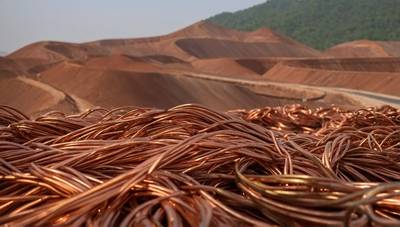The US and India are the new drivers of copper demand as China's juggernaut slows.
Over the next decade, copper consumption in India and the United States will overtake China as the demand for the metal in China slows.
Beijing's expansion of industrial and infrastructure has fueled a rally which has seen copper prices soar to over $10,000 per metric ton, from $1500 25 years earlier.
Analysts expect that other factors, such as demand and prices, will increasingly influence copper's price.
Producers, consumers, traders, and investors will need to adapt to the market's many drivers.
"China will reduce the rate of its copper consumption and stockpiling." "We are returning to the old-fashioned drivers for copper, which is essentially replacement cycles outside China," Panmure Liberum analyst Tom Price said.
China's demand for refined Copper, estimated at 15 million tons in this year, is likely to drop as a result of the U.S., and other countries, promoting local manufacturing.
Copper demand outside China is expected to grow due to the need for data centres to support AI and the upgrading of power grid infrastructure.
"China has constructed its infrastructure, which includes its grid for power distribution. "Its activity will decline to match its requirement," Price said, forecasting that Chinese demand in 2031 will be 6% less than it was in 2026.
Price predicts that China will account 52% of the global consumption of copper primary, or around 27 million tonnes, in 2031, compared to 57% in 2016.
He expects the U.S. to have a copper demand of nearly 2.2 million tonnes in 2031. This is up by almost 50% from 2026. For India, he predicts a copper demand that will rise above 1,000,000 tons. This represents a more than 30% increase.
"INCREASING PUSHBACK FROM COUNTRIES OF THE WEST"
Analysts expect that President Donald Trump will also impose a 50% tariff on copper pipes and wires to encourage local production.
China is likely to lose a large market for its copper pipe exports. Trade Data Monitor ranked the U.S. the fourth largest market for this product in China.
TDM data show that Beijing could lose a significant market. Last year it imported 14,4 million tons directly from China of copper tubes and pipe. In the first seven month of this year they totaled about eight million tons.
Duncan Hobbs is the research director for Concord Resources. He said that "China's production of manufactured goods will likely slow down in some degree due to increased pushback from countries in Western Europe." These exports include copper wire for power grid infrastructure. In its last network-infrastructure review a decade ago, the U.S. Department of Energy found 70% of U.S. transmission lines were more than 25 years old.
India, meanwhile, is expanding its transmission network to help it reach its goal of 500 gigawatts of non-fossil-fuel-based power by 2030.
Benchmark Mineral Intelligence, a consultancy in Asia, expects the demand for copper to increase by 25%, to 9.2 million tonnes, between 2025-2030, excluding China.
BMI anticipates a 35% increase in demand for electric infrastructure, which includes power grids, generation, data centers and telecoms.
BMI's China forecasts are 4 and 11 percent respectively.
MODERNISING INFRASTRUCTURE
Grid modernisation in the West is primarily about modernising infrastructure. It will be gradual and not as copper-intensive as China's building from scratch.
Robert Edwards, the principal analyst of metals consultancy CRU, had expected China's impact on the copper market would wane over a few years. This did not happen because of Chinese investments in electric vehicles and renewables, as well as its power grid.
CRU predicts that China's consumption will fall from 59% to 27,62 million tons of copper in 2015 to 57% to 31,36 million tons of recycled and mined copper by 2030.
The demand growth potential of China is very limited. Edwards said that you should expect to see more growth around the globe. (Reporting and editing by Veronica Brown, Alexander Smith, and Pratima Deai)
(source: Reuters)






